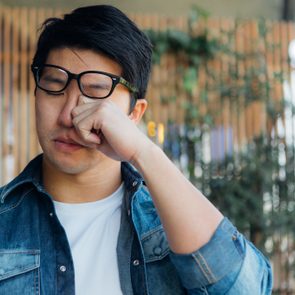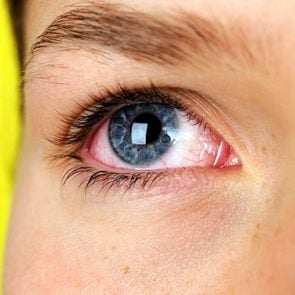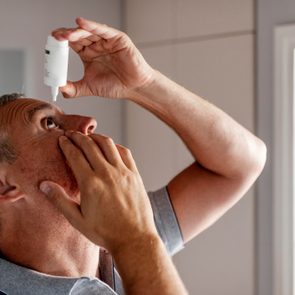One Woman’s Battle With Dry Eyes—and How She Found Relief
Updated: Jun. 30, 2021
Maria Stoehr struggled for months before discovering that her dry and irritated eyes were due to a treatable eye disorder called meibomian gland dysfunction.
Dealing with dry eyes
We’ve all had itchy eyes at times, but it’s usually a temporary issue. That’s why Maria Stoehr wasn’t too worried about her bothersome eyes. The Las Vegas resident blamed the dry, desert conditions for her scratchy, burning symptoms. “When I first started getting dry eyes three years ago, it was annoying but it was nothing a few eye drops couldn’t handle,” she says.
But as Stoehr discovered, persistent symptoms may indicate that dry eyes may be to blame: While a number of conditions may be the source of dry eyes, the issue requires special care and treatment.

Time for diagnosis
Stoehr, who is a teacher, soon realized her eye issues were serious: “I woke up one morning with a very red, scratchy, painful eye. It went away on its own over the day but dry, bloodshot eyes soon became a pattern. They really hurt and were affecting my ability to function at home and work. I was having an especially difficult time focusing on my computer. I knew I couldn’t ignore it anymore.”
She made an appointment with an ophthalmologist. “The doctor confirmed that I did have extremely dry and irritated eyes, and diagnosed me with meibomian gland dysfunction.”
The common eye disorder no one talks about
Your tears are made out of oil, water, and mucus, and they need all three ingredients to keep your eyes moist and protected.
Your eyelids are ringed with tiny glands that produce meibum, the oil that makes the protective layer of your tears.
When the meibomian glands get clogged, you produce fewer tears and they are of a lower quality, leading to chronic dry eyes.
Meibomian gland dysfunction is very common and many people don’t realize they have it as it’s easy to chalk dry eyes up to age or stuff in your environment.
However, a 2018 study in Acta Ophthalmologica found that 70 percent of people suffering from dry eyes had meibomian gland dysfunction.
Researchers looked at the medical records of 1,372 patients complaining of dry eyes and found the vast majority showed signs of this disorder. They also found that gender matters—of the meibomian gland dysfunction group, 70 percent were women.
Some of the other potential sources of dry eye symptoms include rosacea, blepharitis (inflammation of eyelids), Sjögren’s syndrome (an immune system disorder), and macular degeneration, a common cause of blindness
(Make sure you know these signs that your eyes might be in danger.)
Risk factors for dry eyes
Lifestyle factors and medical conditions can both contribute to dry eyes, says Darren Gregory, MD, an ophthalmologist at UCHealth Sue Anschutz-Rodgers Eye Center and an assistant professor at the University of Colorado School of Medicine.
Location, location, location
Living in a desert is definitely an issue. “Low humidity makes our tears dry up faster than usual, so the skin on the surface of the eye gets dry and irritated more easily,” Dr. Gregory explains.
Living at a high altitude can also cause dry eyes. “Low oxygen in the air adds to the irritation of the skin on the surface of the eye which gets some of its oxygen directly from the air, rather than from blood flow,” he says.
Screen time
Digital devices, including phones, tablets, TVs, and computers, are a common culprit. “We blink less when using these devices which leads to fewer tears and drier eyes,” says Dr. Gregory.
Blowing indoor air
Anything with airflow has a drying effect on the eyes, including air conditioning, heaters, and fans, according to Dr. Gregory.
Windy outdoor air
Participating in outdoor activities without eye protection leads to increased wind exposure. Wind wicks the moisture away from your eyes, says Dr. Gregory.
Underlying health conditions
There are several types of illnesses that can directly cause dry eyes, says Dr. Gregory.
Autoimmune diseases, including Sjogren’s Syndrome and rheumatoid arthritis, are associated with decreased tear production and dry eyes.
Hormonal disorders, like Grave’s disease, can cause dry eyes due to poor eyelid closure and inflammation of the surface of the eyes.
Illnesses that affect muscle control, like Parkinson’s disease, can decrease blink rate and lessen tear production.
(Check out these secrets your eye doctor won’t tell you.)
Unclogging tiny glands
Stoehr’s doctor told her that if she didn’t treat it, the problem would only become worse so she decided to get it taken care of right away.
“The treatment for MGD was a pretty intense scrubbing of my lid margin, the very edge of my eyelid,” says Stoehr. “This was followed by a warm massage of my eyes to soften the oils and unclog the glands.”
As daunting as that sounds, she was able to have the process done in her doctor’s office. “It helped, but my doctor told me that what I did to take care of my eyes afterward would make all the difference.”
Keeping the glands clear
To prevent her meibomian glands from clogging up, Stoehr’s doctor gave her a very specific list of instructions.
-
Use an oil-free makeup remover to gently remove my eye makeup each day. (No sleeping with mascara on.)
-
Follow this by cleaning the eye area with a tea tree oil eye cleanser.
-
Apply a vitamin A eye ointment each night before bed.
-
Do daily blinking exercises designed to help restore tear production.
-
Follow the “20-20-20 rule” when using screens: After 20 minutes of focusing on a screen, redirect your gaze to look at something 20 feet away for 20 seconds.
-
Sleep with an eye mask. Because Stoehr slept with a fan on, the mask could prevent the breeze from drying out her eyes.
- Use blue light blocking glasses when she needs to work on the computer for a long time.
Preventing dry eyes
In addition to keeping the glands clear, it’s also important to take proactive steps to prevent dry eyes, says Dr. Gregory. He recommends:
-
Minimize airflow in your immediate environment by shutting vents, at home and in the car, and by turning off fans.
-
Supplement tears with over-the-counter drops and ointments.
-
If those aren’t enough, your doctor can prescribe stronger medications.
There are some medical solutions for dry eyes as well, he says. Your doctor can plug your tear ducts/tear drains to keep tears on your eye longer.
Treat any underlying medical conditions. And it’s worth getting evaluated for any anatomical eyelid problems that may impact the quality of blinking and eyelid closure.
Dry eyes in general and Meibomian gland dysfunction specifically aren’t easily cured but they can be managed, allowing you to be much more comfortable, he says.
(You can also try these home remedies for dry eyes that doctors recommend.)
The key is staying consistent
Stoehr stuck to her doctor’s advice and is doing much better. “I was vigilant about following all of my doctor’s orders and it worked, my eyes were great for two years,” says Stoehr. “I found that if I stop any one of the treatment steps, I notice an immediate change.”
When she recently began to have flare-ups again, she went back to her doctor. “I needed a second unclogging treatment. After that, I am feeling much better overall and my eyes are not as red—but I do still get dry eye symptoms occasionally and they are annoying.”
The biggest lesson is to be proactive about managing the issue, Stoehr says. “Some mornings I need to use my eye drops first thing—before I can open my eyes and focus. But overall I’m feeling so much better and feel like this is something I can deal with now.”




















